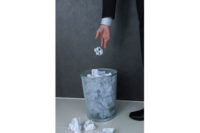Because ANSI Z87.1-2003 became effective in August, safety professionals need to familiarize themselves with the new standard as soon as possible. In this article, we'll try to clarify the major changes in Z87.1-2003, officially called the "American National Standard Practice for Occupational and Educational Personal Eye Protective Devices."
First, you may be surprised to learn that the new standard was not developed by ANSI. In fact, ANSI doesn't write standards at all. ANSI's role is as an accrediting body. The American Society of Safety Engineers (ASSE), as secretariat for ANSI's ANSI Z87 committee, developed the new standard. This is important to know because safety professionals with questions should contact ASSE for answers. (See contact information for ASSE in sidebar below.)
Users win
Since this industrial eyewear standard was last revised in 1989, eyewear styles are not the only thing that has changed. New materials and technologies have led to improvements in protection, comfort, design and style. Eye protection that is compliant with the new Z87.1-2003 standard will provide better coverage, and additional benefits for users will most likely include lighter weight, greater comfort and wider choice of styles. While making eye protection that meets the new standard's requirements, manufacturers can also make eye protection that is more appealing to the eye and to the wearer.
ANSI Z87.1-2003 covers the same eye protectors (spectacles, goggles, faceshields, welding helmets and handshields) as the old standard. However, the new standard has also been expanded to include performance requirements for full-face and loose-fitting respirators (for both welding and non-welding applications), many of which are the same as those for spectacle lenses.
Impact resistance
Perhaps the new standard's most significant change is the introduction of two categories of impact resistance: basic and high. In effect, this dual-tier approach will divide the eye protection world between non-plano (prescription) and plano products.For non-plano lenses, the new standard still has thickness requirements for basic and high-impact products. Lens thickness in non-plano eyewear is an important factor for maximizing lens retention in frames during high-velocity impacts. For high-impact plano lenses, however, the thickness requirement has been eliminated.
In some cases, testing procedures have changed, with emphasis now placed on product performance instead of materials used. For example, the new High-Velocity Impact Test states that ". . . spectacles shall be capable of resisting an impact from a 6.35 mm (0.25 in.) diameter steel ball traveling at a velocity of 45.7m/s (150 ft/s)." Previously, spectacle lenses had to be at least 2.0 mm thick and resist such an impact. Now, spectacles with high-impact plano lenses need only to survive this and other impact and penetration tests.
Freed from the thickness requirement, manufacturers can explore the use of lighter, tougher materials. This is important because, though a 2.0 mm thickness does not cause unacceptable optical distortion for flat or slightly curved lenses, it does so in the sharper curves required for wraparound lenses.
The new standard will allow manufacturers to thin the lens material where the curve is sharpest. The result will be a thinner, lighter, distortion-free lens with better side protection. Because increased side protection is called for, the new impact testing occurs farther back (toward the ear) in the sideshield area of the eyewear.
New, even more fashionable eyewear styles are now possible. Look for increased use of wraparound designs.
New markings
Perhaps the most visible change will be the way that Z87.1-2003-compliant plano eye protection products will be marked. As with the old standard, all removable lenses, both plano and non-plano, must bear a permanent manufacturer's logo or mark. A brand new requirement is that high-impact lenses will be marked with a plus sign (+).One-piece plano spectacles, like typical plant visitor eyewear, require only one mark: either "Z87" or "Z87+", whichever is applicable. This mark can appear on the frame, temple or lens.
Here's where the new standard may have some safety professionals scratching their heads. They may wonder how to tell the difference between an old-standard Z87 protector and a new-standard Z87 protector. It's an important difference, because new-standard Z87 protectors offer only basic-impact protection.
Basic- and high-impact non-plano lenses must meet many of the same performance requirements as plano lenses. Basic-impact non-plano lenses need to bear only the manufacturer's mark or logo. High-impact non-plano lenses will be identified with a "+". Under the new standard, non-plano frames that meet Z87.1 performance requirements will bear the mark "Z87-2".
The new standard attempts to clarify possible confusion by requiring basic-impact protectors to bear warning labels ". . . to alert the user when the lens(es) of a protector meet(s) only the basic impact requirements. . ." The label or tag is to be removed only by the user. But after the warning label is gone, there may be no way to tell the difference.
Under the new standard, manufacturers who make plano protective eyewear will find little incentive to make basic-impact models, as workers tend to opt for the highest level of protection available. It is quite conceivable that Z87 plano products will become a thing of the past.
More options, fewer objections
OSHA believes that contact lenses do not pose additional hazards and can be worn with acceptable plano eyewear. The broader range of styles likely to emerge as a result of the new standard will give contact lens wearers more options. More options mean fewer objections from wearers, which might lead to increased use.
In most cases, the safest choice would be to use Z87+ eyewear for all plano applications.
SIDEBAR: What to look for:
SIDEBAR: Where to find the standard
The new ANSI Z87.1-2003 standard is available for purchase from the American Society of Safety Engineers (ASSE), 1800 East Oakton St., Des Plaines, IL 60018. You can reach them at www.asse.org, or call (847) 699-2929.
The standard includes 23 figures, selection charts, testing apparatus and five appendices. The list price is $53. ASSE member price is $37.00, and AIHA/ACHMM member price is $45.00.
